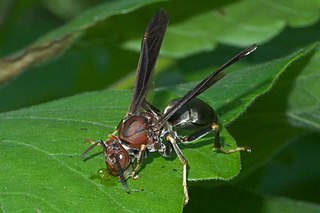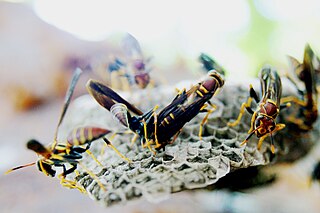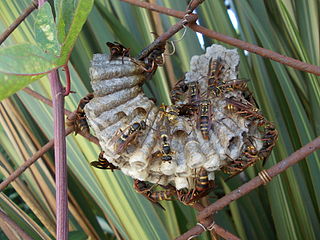
Wasps of the cosmopolitan genus Polistes are the most familiar of the polistine wasps, and are the most common type of paper wasp in North America. Walter Ebeling coined the vernacular name "umbrella wasps" for this genus in 1975 to distinguish it from other types of paper wasp, in reference to the form of their nests. It is also the single largest genus within the family Vespidae, with over 300 recognized species and subspecies. Their innate preferences for nest-building sites leads them to commonly build nests on human habitation, where they can be very unwelcome; although generally not aggressive, they can be provoked into defending their nests. All species are predatory, and they may consume large numbers of caterpillars, in which respect they are generally considered beneficial. The European paper wasp, Polistes dominula, was introduced into the US about 1981 and has quickly spread throughout most of the country, in most cases replacing native species within a few years. This species is very commonly mistaken for a yellow jacket, as it is black, strongly marked with yellow, and quite different from the native North American species of Polistes. The cuckoo wasp, Polistes semenowi, is an obligate social parasite, whose only host is P. dominula. Polistes metricus adults malaxate their insect prey by chewing them into a pulp, sucking out and ingesting the body fluids, then feeding the rest of the morsel to their larvae. The most widely distributed South American wasp species, Polistes versicolor, is particularly common in the southeastern Brazilian states. This social wasp is commonly referred to as the yellow paper wasp due to the distinct yellow bands found on its thorax and abdomen. Polistes wasps can be identified by their characteristic flight; their long legs dangle below their bodies, which are also more slender than a yellow jacket.

The European paper wasp is one of the most common and well-known species of social wasps in the genus Polistes. Its diet is more diverse than those of most Polistes species—many genera of insects versus mainly caterpillars in other Polistes—giving it superior survivability compared to other wasp species during a shortage of resources.

Polistes gallicus is a species of paper wasp found in various parts of Europe, excluding England, Denmark, and Scandinavia, from warmer climates to cooler regions north of the Alps. Nests of these social insects are created in these various conditions. The Polistes species use an oral secretion to construct their nests, which consist of a combination of saliva and chewed plant fibers. This structural mixture physically protects the nest from various harsh elements and from weathering over time.

Ropalidia marginata is an Old World species of paper wasp. It is primitively eusocial, not showing the same bias in brood care seen in other social insects with greater asymmetry in relatedness. The species employs a variety of colony founding strategies, sometimes with single founders and sometimes in groups of variable number. The queen does not use physical dominance to control workers; there is evidence of pheromones being used to suppress other female workers from overtaking queenship.

Polistes annularis is a species of paper wasp found throughout the eastern half of the United States. This species of red paper wasp is known for its large size and its red-and-black coloration and is variably referred to as a ringed paper wasp or jack Spaniard wasp. It builds its nest under overhangs near bodies of water that minimize the amount of sunlight penetration. It clusters its nests together in large aggregations, and consumes nectar and other insects. Its principal predator is the ant, although birds are also known to prey on it. Unlike other wasps, P. annularis is relatively robust in winter conditions, and has also been observed to store honey in advance of hibernation. This species has also been used as a model species to demonstrate the ability to use microsatellite markers in maternity assignment of social insects.

Polistes metricus is a wasp native to North America. In the United States, it ranges throughout the southern Midwest, the South, and as far northeast as New York, but has recently been spotted in southwest Ontario. A single female specimen has also been reported from Dryden, Maine. Polistes metricus is dark colored, with yellow tarsi and black tibia. Nests of Polistes metricus can be found attached to the sides of buildings, trees, and shrubbery.

Polistes fuscatus, whose common name is the dark or northern paper wasp, is widely found in eastern North America, from southern Canada through the southern United States. It often nests around human development. However, it greatly prefers areas in which wood is readily available for use as nest material, therefore they are also found near and in woodlands and savannas. P. fuscatus is a social wasp that is part of a complex society based around a single dominant foundress along with other cofoundresses and a dominance hierarchy.

Polistes exclamans, the Guinea paper wasp, is a social wasp and is part of the family Vespidae of the order Hymenoptera. It is found throughout the United States, Mexico, the Bahamas, Jamaica and parts of Canada. Due to solitary nest founding by queens, P. exclamans has extended its range in the past few decades and now covers the eastern half of the United States, as well as part of the north. This expansion is typically attributed to changing global climate and temperatures. P. exclamans has three specific castes, including males, workers, and queens, but the dominance hierarchy is further distinguished by age. The older the wasp is, the higher it is in ranking within the colony. In most P. exclamans nests, there is one queen who lays all the eggs in the colony. The physiological similarities between the worker and queen castes have led to experiments attempting to distinguish the characteristics of these two castes and how they are determined, though males have easily identifiable physiological characteristics. Since P. exclamans live in relatively small, open combed nests, they are often subject to predators and parasites, such as Chalcoela iphitalis, Elasmus polistis, and birds. P. exclamans have defense and recognition strategies that help protect against these predators and parasites.

Polistes instabilis, a type of paper wasp, is a neotropical, eusocial wasp that can be found in tropical and subtropical areas such as Central America and South America. It can be easily identified with its characteristic yellow, brown, and reddish markings, and it builds nests made from chewing plant fibers and making them into paper.

Polistes nimpha is a eusocial paper wasp found all over Europe, with particular sightings in Turkey, Finland, Estonia, and Latvia. It is also found in northern Africa, Pakistan, Iran, India, Kazakhstan, Mongolia, and China. The climate in these areas is relatively cold and snowy in the winter, while summers are usually hot and dry, with steppe vegetation. Polistes nimpha colonies are relatively small and easily manipulated.

Polistes snelleni, the Japanese paper wasp, is a common social wasp species in central and northern Japan. P. snelleni is also found in northern China, Korea, and the Russian Far East. Due to the different climates in these regions, P. snelleni is able to adapt to different temperatures and climatic conditions. P. snelleni is typically found in hilly or submontane areas, so they are classified in the semi-highland category.

Polistes bellicosus is a social paper wasp from the order Hymenoptera typically found within Texas, namely the Houston area. Like other paper wasps, Polistes bellicosus build nests by manipulating exposed fibers into paper to create cells. P. bellicosus often rebuild their nests at least once per colony season due to predation.

Polistes atrimandibularis is one of three obligate social parasites among the Polistes wasps found in Europe. Of the four social paper wasp parasite species known, it is the smallest. It parasitizes multiple species such as P. dominula, P. nimpha, P. associus, P. gallicus, and P. biglumis. Females of P. atrimandibularis are unable to build a nest or produce workers, and therefore rely entirely on the host colony.

Belonogaster petiolata is a species of primitively eusocial wasp that dwells in southern Africa, in temperate or subhumid climate zones. This wasp species has a strong presence in South Africa and has also been seen in northern Johannesburg. Many colonies can be found in caves. The Sterkfontein Caves in South Africa, for example, contain large populations of B. petiolata.

Polistes biglumis is a species of social wasp within Polistes, the most common genus of paper wasp. It is distinguished mainly by its tendency to reside in montane climates in meadows or alpine areas. Selection pressure from the wasp's environment has led to several idiosyncrasies of its behavior and lifecycle with respect to its relative species in the genus Polistes. It alone among paper wasps is often polyandrous. In addition, it has a truncated nesting season that gives rise to unique competitive dynamics among females of the species. P. biglumis wasps use an odor-based recognition system that is the basis for all wasp-to-wasp interaction of the species. The wasp's lifecycle is highly intertwined with that of Polistes atrimandibularis, an obligate social parasite wasp that frequently invades the combs of P. biglumis wasps.
Ropalidia plebeiana is a eusocial temperate paper wasp. It is unique, as it is the only temperate wasp in the typically tropical Ropalidia genus. R. plebeiana is widely distributed in eastern Australia, and recently have been found making huge nest aggregations, with thousands of nests on trunks of trees, in south-eastern New South Wales.

Polistes versicolor, also known as the variegated paper wasp or yellow paper wasp, is a subtropical social wasp within Polistes, the most common genus of paper wasp. It is the most widely distributed of South American wasp species and is particularly common in the Southeastern Brazilian states. This social wasp is commonly referred to as the yellow paper wasp due to the distinct yellow bands found on its thorax and abdomen. The P. versicolor nest, made of chewed vegetable fiber, is typically a single, uncovered comb attached to the substratum by a single petiole. The yellow wasp is frequently found in urban areas. New nests and colonies are usually founded by an association of females, sometimes in human buildings. The P. versicolor colony cycle broadly ranges from 3 to 10 months, although there appears to be no relationship between the colony's development and the season of the year. While yellow paper wasps do have clear annual colony cycles, many young queens have the opportunity to hibernate during the winter, forming optional winter aggregations. Dominance hierarchies within these aggregations are characterized by physical aggression of the dominant female(s) towards the associated females, who tend to be sisters. Wagging movements are also often used as a form of communication within the colony. The yellow paper wasp is generally predatory, capturing a wide range of insects, although it often feeds on pollen and nectar as well. Therefore, P. versicolor can be useful as a pollinator or as effective pest control.

Polistes dorsalis is a species of social wasps that can be found throughout various parts of North America. It is classified under the Vespidae within the genus of Polistes. Male Polistes dorsalis wasps can be distinguished from other Polistes species by their distinctly prominent median tubercle of sternum 7. Both sexes can also be recognized due to their v- shaped yellow markings on their head. They are distributed widely across North America and can be found in sheltered nests, typically closer to the ground. These wasps live in a dominance hierarchy in which the queen's role differs from that of ordinary workers. When threatened, these wasps can deliver moderately painful stings. Their venom might also be of human interest for their antimicrobial uses.
Polistes erythrocephalus is a species of paper wasp in the subfamily Polistinae of family Vespidae found in Central and South America. P. erythrocephalus is a eusocial wasp, meaning that it possesses both reproductive and non-reproductive castes. The cooperation between the two castes to raise young demonstrates the altruistic nature of these wasps. P. erythrocephalus exhibits a four-stage colony cycle, as do many other Polistes wasps. This species generally feeds on larvae, occasionally their own, and is preyed upon by species such as army ants.

Mischocyttarus mexicanus is a New World species of paper wasp that exhibits facultative eusocial behavior and includes at least two subspecies living in the southern United States and Central America. This social wasp species is a good model for studying the selective advantage of different nesting tactics within a single species. M. mexicanus females can form nests both as individuals and as members of a colony, and are even known to switch between these two nesting strategies throughout their life, which is an unusual phenomenon in the field of social biology. Individuals in a colony have particular social roles that are plastic, as opposed to rigid castes, and brood parasitism and usurpation have been observed between unrelated conspecifics. They nest in a variety of types of plants and human constructions, although they have most frequently been observed in palm trees, and they are known to interact with a number of other species as prey, competitors over resources, or foragers.


















